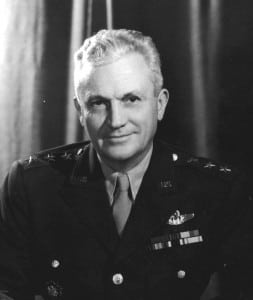I talk to many knowledgeable people about Tennessee history. Perhaps no fact astonishes them more than the following:
Joint Base Andrews (formerly known as Andrews Air Force Base) — the base used by the president of the United States — was named for a famous U.S. Army general from Nashville.

Frank Maxwell Andrews is considered one of the founders of the U.S. Air Force. For a time, he was commander of all U.S. troops in the European Theater of Operations during World War II. Had he not been killed in a plane crash, he might have been head of the Normandy invasion instead of Dwight Eisenhower.
Andrews was distantly related to two Tennessee governors (John C. Brown and Neill S. Brown). Born in Nashville in 1884, he grew up in the South Nashville neighborhood known as Waverly Place.
Today, Waverly Place is in the inner-city, but not so in the 1890s. “There were cows and chickens (in our yard),” his sister, Josephine Sykes, recalled years later. “We sold milk and eggs, and the boys delivered them in our neighborhood.”
When he graduated from Montgomery Bell Academy, Andrews applied to the U.S. Military Academy at West Point and made the waiting list as a “second alternate.”
Many years later, his sister remembered great excitement in the household when they received a phone call saying that her brother’s spot at West Point was secured.
“Daddy was very happy and pleased,” she wrote. “Mother was in tears. She knew what it would mean — being away from home.”

Andrews graduated 42nd in his class and became a junior officer in 1906. For the first several years of his Army career, he was in the cavalry. In 1917, he was shifted to the U.S. Army’s new aviation section and became a flyer. Andrews stayed in the aviation side for the rest of his career, working his way up through the ranks with assignments such as chief of the Army Air Corps’ Training and Operations Division.
Regardless of his rank, he never strayed far from the cockpit, and in August 1935, he broke three speed records that had formerly been held by Charles Lindbergh.
In 1935, the U.S. Army consolidated all of its Air Corps tactical units into a single command. General Douglas MacArthur promoted Andrews to the rank of brigadier general and made him commander of this new unit. “A one-time cavalryman, Col. Andrews is tough, fiftyish, handsome,” reported Time magazine. “Army wives call him the best-looking man in service and like to remember the romantic thrill he gave them in 1914 by taking his bride on a horseback honeymoon in Virginia.”
As an important leader within Army policy circles, Andrews advocated the Army’s purchase of heavy, four-engine B-17 bombers instead of smaller and cheaper bombers such as the B-18. When, at first, the U.S. Army leaned toward the B-18, it appeared to end his career. “To many, it appeared that the Army was punishing Andrews for advocating the B-17 so forcefully,” the National Museum of the U.S. Air Force says in an online biography.
However, Gen. George Marshall believed in Andrews and named him one of his senior staff members in 1940.
At different times during World War II, Gen. Andrews was commander of the Caribbean Defense Command and commander of U.S. forces in the Middle East.

At the Casablanca Conference in January 1943, Lt. Gen. Andrews was named commander of all U.S. forces in Europe, replacing Dwight Eisenhower. At this time, the American effort in Europe was focused on long-range bombing and planning for a mainland invasion.
Unfortunately, Andrews’ tenure as commander of all U.S. forces in Europe was not a long one. On May 3, 1943, during an inspection tour, Andrews was killed when his B-24 crashed while trying to land in Iceland. Fourteen people were killed in the tragedy. At that time, Andrews was the highest-ranking allied officer to die in the line of duty in the war.
After his death, many people recalled something that Andrews once said when asked about the amount of time he spent flying. “I don’t want to be one of those generals who die in bed,” he said.
For several decades, Andrews Air Force Base (now Joint Base Andrews) has been well-known as the base from which the president of the United States flies. However, to the best of my knowledge, there are no places named for Frank Maxwell Andrews in his native state of Tennessee — not even a bridge, highway or small airfield!
Some World War II historians have speculated that, had he still been alive, Gen. Frank Andrews would have been chosen by Gen. Marshall to be head of the Normandy invasion. Had he done so, it is interesting to wonder how this might have changed the invasion.
“Andrews might, for instance, have been more inclined to direct resources to his old friend Patton as he pushed toward Metz, Nancy and the German border in August 1944,” E. Thomas Wood wrote in “The Man Who Would Be Ike,” an article in the May/June 2010 issue of World War II. “He might have let the Sixth Army Group cross the Rhine River after reaching it in late November, rather than halting the advance as Eisenhower did.” That decision could have brought the war to an earlier end, saving thousands of lives.
Of course, we will never know. What we do know is what some of his colleagues said about him. “He was a great man, of great breadth of concept, and he would have been one of the truly great leaders if he had survived,” said Gen. James Doolittle.



